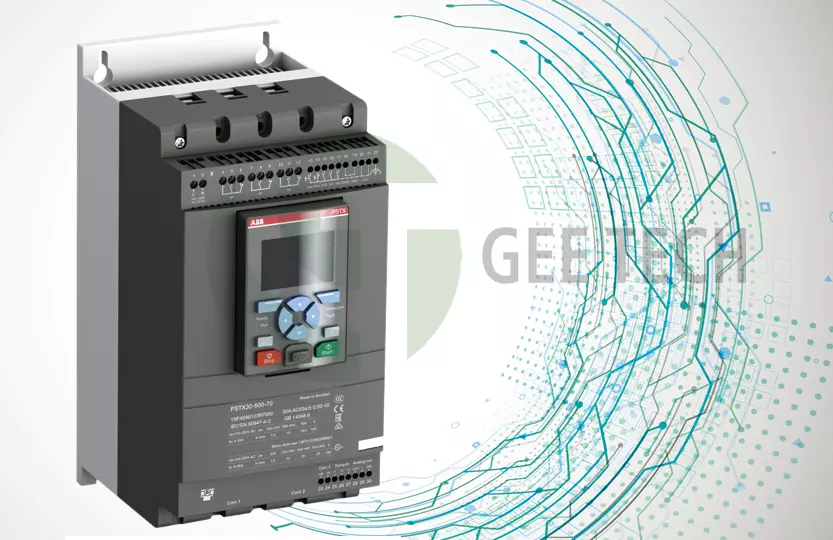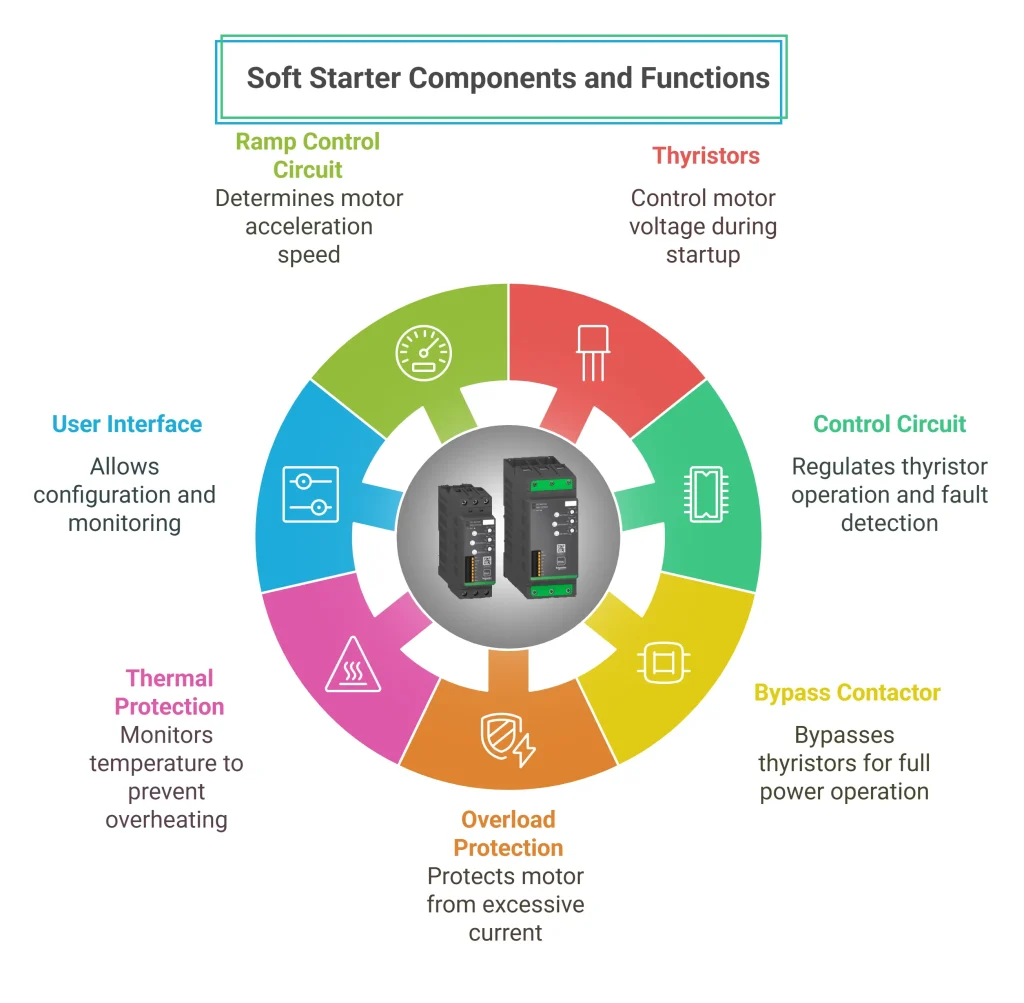
Introduction
In today’s industrial and commercial environments, improving energy efficiency and reducing operational costs are top priorities. One effective solution that addresses both is the soft starter — a motor control device that minimizes inrush current and mechanical stress during motor startup. This article explores how soft starters contribute to energy savings, reduce maintenance expenses, and offer long-term benefits across various applications.
What Is a Soft Starter?
A soft starter is an electronic device designed to gradually increase the voltage supplied to an electric motor, enabling smooth acceleration and deceleration. Unlike direct-on-line (DOL) starters that subject motors to full voltage instantly, soft starters ramp up power gently, limiting starting torque and inrush current.
This controlled startup reduces mechanical shock on motors and connected systems such as pumps, conveyors, and compressors, which helps extend the lifespan of both the motor and the driven equipment.

Key Components of a Soft Starter
A soft starter is designed to reduce the mechanical and electrical stress on motors during startup. Below are the essential components that enable this function:
1. Thyristors (Silicon-Controlled Rectifiers – SCRs)
Thyristors are crucial semiconductor devices used to control the motor’s starting voltage. Acting as electronic switches, they progressively increase voltage during motor startup, minimizing the inrush current that typically occurs in direct-on-line starts.
2. Control Circuit
The control circuit manages the operation of the thyristors by adjusting their firing angles. This ensures a smooth and controlled ramp-up of voltage, allowing for gradual motor acceleration. It also incorporates features for fault detection and motor protection.
3. Bypass Contactor
Once the motor reaches full speed, the bypass contactor engages to bypass the thyristors. This transition allows the motor to run at full power with improved efficiency and reduced heat generation in the soft starter itself.
4. Overload Protection
Many soft starters are equipped with overload protection systems that monitor current levels. If the motor draws excessive current during startup, the system limits it to prevent overheating and potential motor damage.
5. Thermal Protection
Thermal protection continuously monitors the temperature of the motor and soft starter. If temperatures exceed safe thresholds, the system can trigger alarms or initiate shutdown to protect components from thermal damage.
6. Human-Machine Interface (HMI)
Modern soft starters feature a user-friendly HMI panel that allows operators to configure settings, monitor system status, and troubleshoot issues. Parameters like ramp time, voltage limits, and protection thresholds can be easily adjusted through the interface.
7. Ramp Control Circuit
The ramp control circuit plays a key role in motor acceleration. It regulates how quickly voltage is applied to the motor, ensuring a gradual start that reduces both mechanical wear and electrical stress.
Key Features of Soft Starters:
- Controlled motor startup and stop
- Reduced mechanical wear and tear
- Lower starting current
- Enhanced system reliability
Working Principle of Soft Starters
The working principle of a soft starter revolves around gradually increasing the voltage supplied to an electric motor during startup, thereby reducing mechanical stress and electrical surges. This controlled approach ensures a smoother and safer motor start, extending the lifespan of both the motor and connected equipment.
Controlled Voltage Ramp-Up
Instead of applying full voltage instantly—as in direct-on-line (DOL) starts—a soft starter progressively feeds current to the motor. This controlled voltage ramp-up reduces initial inrush current and limits starting torque, making it especially suitable for three-phase induction motors.
Role of Thyristors and SCRs
Soft starters primarily rely on thyristors, or silicon-controlled rectifiers (SCRs), which act as high-speed semiconductor switches. These components adjust the voltage supplied to the motor without altering its frequency, enabling precise control over motor startup behavior.
Each SCR has four layers of semiconductor material and operates in response to gate signals from the control circuitry. By adjusting the firing angle of the SCRs, the soft starter smoothly regulates the power flow during acceleration.
Protection Against Electrical and Mechanical Stress
By limiting the voltage and torque at startup, soft starters prevent sudden mechanical shocks and electrical spikes that could otherwise damage the motor windings or connected systems. This reduces the risk of overheating, energy waste, and costly maintenance.
Start/Stop Functionality
Soft starters also include control settings for both startup and shutdown. During shutdown, the soft starter can ramp down the voltage instead of cutting power instantly, minimizing electrical wear and enabling soft stops where required—ideal for pumps, fans, and conveyors.
Voltage Limitation and Parameter Settings
Advanced models allow users to configure voltage thresholds and ramp times through a user interface or digital panel. These parameters ensure that the motor does not exceed a safe voltage level during operation, adding an extra layer of protection against overcurrent or voltage surges.
How Soft Starters Improve Energy Efficiency
A major advantage of using soft starters is energy efficiency improvement, particularly during motor startup. When motors start at full voltage, the inrush current can be 6 to 8 times higher than the rated current. This surge not only strains the motor but also spikes energy consumption.
By limiting the inrush current:
- Soft starters lower peak demand charges on electrical systems
- Reduce voltage dips in the network
- Help maintain power quality
- Support compliance with energy-saving initiatives
Though soft starters don’t reduce energy during steady-state motor operation (unlike variable frequency drives), they significantly cut energy waste during frequent starts and stops — making them ideal for applications like HVAC systems, conveyors, and water pumps.
Lower Maintenance Costs and Equipment Longevity
Frequent startups at high torque can degrade mechanical components such as bearings, shafts, belts, and couplings. Soft starters minimize mechanical shock, which leads to:
- Less wear and tear on motors and attached machinery
- Extended lifespan of motors and production equipment
- Reduced frequency of repairs
- Lower total cost of ownership (TCO)
Additionally, soft starters prevent thermal and electrical stress on motor windings, reducing the risk of insulation damage or early motor failure. Over time, this translates into fewer unplanned downtimes and optimized maintenance schedules.
Additional Benefits of Soft Starters
Compact design: Easy to integrate into existing control panels
Lower installation costs: Fewer components compared to alternative control methods
Enhanced safety: Reduced risk of electrical and mechanical failures
Improved system uptime: Smooth starts and stops prevent sudden breakdowns
Applications Across Industries
Soft starters are widely used in:
- Water treatment plants
- Oil & gas
- Mining
- HVAC systems
- Material handling
- Agriculture
Their versatility makes them a practical and economical choice for any operation involving three-phase induction motors.
Conclusion
Investing in soft starters is a smart move for industries aiming to cut costs and boost efficiency. By controlling startup current and torque, soft starters improve energy performance, protect mechanical components, and reduce maintenance needs. Their simple yet effective design helps businesses optimize operations, extend equipment life, and achieve sustainable growth with minimal environmental impact.



















